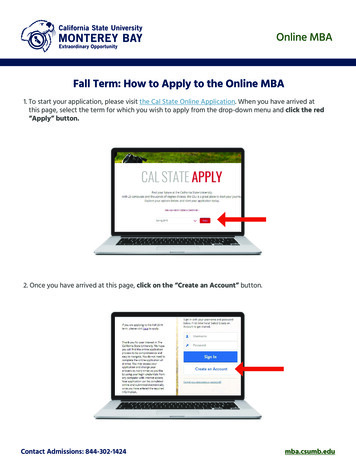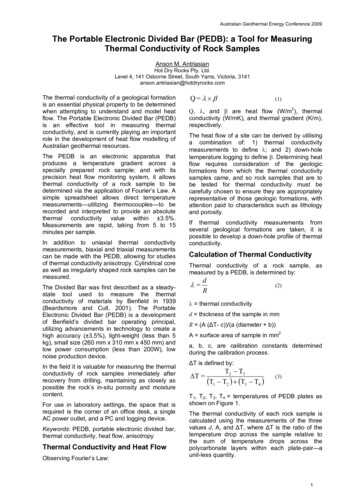
Transcription
PORTABLEMBAinPROJECTMANAGEMENTEDITED BYERIC VERZUHJohn Wiley & Sons, Inc.
PORTABLEMBAinPROJECTMANAGEMENT
The Portable MBA SeriesThe Portable MBA, Fourth Edition, Robert Bruner, Mark Eaker,R. Edward Freeman, Robert Spekman, Elizabeth Teisberg, andS. VenkataramanThe Portable MBA Desk Reference, Second Edition, Nitin NohriaThe Portable MBA in Economics, Philip K. Y. YoungThe Portable MBA in Entrepreneurship, Second Edition, William D. BygraveThe Portable MBA in Entrepreneurship Case Studies, William D. BygraveThe Portable MBA in Finance and Accounting, Third Edition, John LeslieLivingstone and Theodore GrossmanThe Portable MBA in Investment, Peter L. BernsteinThe Portable MBA in Management, Second Edition, Allan R. CohenThe Portable MBA in Market-Driven Management: Using the New MarketingConcept to Create a Customer-Oriented Company, FrederickE. WebsterThe Portable MBA in Marketing, Second Edition, Alexander Hiam andCharles ScheweThe Portable MBA in New Product Development: Managing and Forecastingfor Strategic Success, Robert J. ThomasThe Portable MBA in Psychology for Leaders, Dean TjosvoldThe Portable MBA in Real-Time Strategy: Improvising Team-Based Planningfor a Fast-Changing World, Lee Tom Perry, Randall G. Stott, andW. Norman SmallwoodThe Portable MBA in Strategy, Second Edition, Liam Fahey andRobert RandallThe Portable MBA in Total Quality Management: Strategies and TechniquesProven at Today’s Most Successful Companies, Stephen George andArnold Weimerskirch
PORTABLEMBAinPROJECTMANAGEMENTEDITED BYERIC VERZUHJohn Wiley & Sons, Inc.
➇This book is printed on acid-free paper.Copyright 2003 by John Wiley & Sons, Inc. All rights reserved.Published by John Wiley & Sons, Inc., Hoboken, New Jersey.Published simultaneously in Canada.No part of this publication may be reproduced, stored in a retrieval system, or transmitted in anyform or by any means, electronic, mechanical, photocopying, recording, scanning, or other wise, exceptas permitted under Section 107 or 108 of the 1976 United States Copyright Act, without either theprior written permission of the Publisher, or authorization through payment of the appropriate percopy fee to the Copyright Clearance Center, Inc., 222 Rosewood Drive, Danvers, MA 01923, (978)750-8400, fax (978) 750-4470, or on the web at www.copyright.com. Requests to the Publisher forpermission should be addressed to the Permissions Department, John Wiley & Sons, Inc., 111 RiverStreet, Hoboken, NJ 07030, (201) 748-6011, fax (201) 748-6008, e-mail: permcoordinator@wiley.com.Limit of Liability/Disclaimer of Warranty: While the publisher and author have used their bestefforts in preparing this book, they make no representations or warranties with respect to theaccuracy or completeness of the contents of this book and specifically disclaim any impliedwarranties of merchantability or fitness for a particular purpose. No warranty may be created orextended by sales representatives or written sales materials. The advice and strategies containedherein may not be suitable for your situation. The publisher is not engaged in rendering professionalservices, and you should consult a professional where appropriate. Neither the publisher nor authorshall be liable for any loss of profit or any other commercial damages, including but not limited tospecial, incidental, consequential, or other damages.For general information on our other products and services please contact our Customer CareDepartment within the United States at (800) 762-2974, outside the United States at(317) 572-3993 or fax (317) 572-4002.Wiley also publishes its books in a variety of electronic formats. Some content that appears in printmay not be available in electronic books. For more information about Wiley products, visit ourWeb site at www.wiley.com.Chapter 3 is abridged from Project Management: A Managerial Approach, 5th edition, by Jack R.Meredith and Samuel J. Mantel Jr. Copyright 2003 by John Wiley & Sons, Inc. This material is usedby permission of John Wiley & Sons, Inc.Chapter 8 is from The Pfeiffer Book of Successful Team-Building Tools, edited by Elaine Beich.Copyright 2001 by John Wiley & Sons, Inc. This material is used by permission of Pfeiffer/JosseyBass, Inc., a subsidiary of John Wiley & Sons, Inc.Chapter 9 is from Managing Sof tware Development Projects, 2nd edition, by Neal Whitten. Copyright 1995 by John Wiley & Sons, Inc. All rights reserved.Chapter 10 is from Mastering Vir tual Teams, 2nd edition, by Deborah L. Duarte and Nancy TennantSnyder. Copyright 2001 by Jossey-Bass, Inc. This material is used by permission of Jossey-Bass,Inc., a subsidiary of John Wiley & Sons, Inc.Chapter 12 Copyright 2003 by the pci group.Chapter 13 is from Creating an Environment for Successful Projects, by Robert J. Graham and RandallL. Englund. Copyright 1997 by Jossey-Bass, Inc. This material is used by permission of Jossey-Bass,Inc., a subsidiary of John Wiley & Sons, Inc.ISBN 0-471-26899-2Printed in the United States of America.10987654321
To my parents, Jim Verzuh and Julie Welle Verzuh,and to my parents-in-law, Larry and Fran Kissler,whose lives and accomplishments continue to be aninspiration.
PrefaceIn the 1990s, project management moved from a little-used industrial engineering discipline to the engine of managing America’s work. Prior to 1990, projectmanagement techniques were unknown to most corporate managers who considered projects to be the realm of engineers or the IS department. In universities, with few exceptions, the only place to learn project management was theindustrial and management engineering program—not even “real engineering.”Fast forward to 2003 and project management has leapt to center stage. Corporations are using the “project management office” to implement consistent project management practices across the enterprise and manage mission-criticalstrategic initiatives. From the CEO’s office down to the frontlines, business andgovernment organizations have “projectized” their work and are looking to theclassic discipline of project management to give them greater productivity andfaster response to changing market conditions. This shift has not gone unnoticed on campus where business schools now offer masters programs in projectmanagement and many graduate and undergraduate curriculums include at leastone course on project management. What prompted this revolution? The American economy is increasingly characterized by change and change means projects; project management is the tool set of the twenty-first century.The growing use of project management mirrors the growing number ofprojects we find in our workplace. In every industry and profession, organizations find a greater proportion of their time and resources are committed toprojects, giving rise to the project-based organization. In the past, many firmsconsidered themselves project based. Consulting firms, construction-relatedbusinesses, aerospace companies, and agencies such as the U.S. Army Corps ofEngineers can find that 80 percent to 100 percent of their revenue/budget isattributable to projects. However, a firm need not be completely devoted toprojects to face the challenges of managing multiple projects or to gain thebenefits of applying the project management discipline. If even 20 percent ofyour organization’s budget or revenue is represented by projects, consider yourself a project-based organization. That isn’t suggesting you try to jam the operations of your entire department or company into the project mold—it isvii
viii Prefacesuggesting that if one-fifth of your budget /revenue is project-based, significantly improving the performance of your projects will have an impact on youroverall bottom line.This book is intended for the leaders of this emerging entity known as theproject-based organization. CIOs, department managers, program managers,and senior project managers being challenged to implement project management—to formalize the processes of managing projects—will find strategiesand standards for leveraging the proven discipline of project management.For our purposes, the project-based organization can be a department, division, or entire company. Government agencies and nonprofits should considerthemselves candidates as well as for-profit businesses. The traditional projectbased firms often focused on a few very large projects or programs. The newbreed of multiproject enterprise is often comprised of many smaller, independent projects. Optimizing performance on one project is already difficult. Optimizing performance across many concurrent projects requires a consciousmethod of management. As we optimize the project portion of the business, wecannot afford to ignore the nonproject side. The goal of this book is to providethe methods and framework necessary to run an organization that must successfully deliver many independent projects.The discipline of project management is well developed. There exist, literally, hundreds of books intended to help us better manage a project. Thebody of knowledge for managing a multiproject organization is far less developed. This book, intended as a resource for leaders of the project-based organization, must address both topics. It is impossible for a CIO, engineeringdirector, vice-president of new product development, or owner of a construction or consulting firm to optimize their organization’s project performance ifshe or he cannot speak the language of project management. At the same time,the discipline of project management is insufficient for managing the entirefirm. Therefore, the strategy of this book is to provide a condensed view of thetraditional project management topics and to assemble the guidelines for managing the organization.Part One introduces the dual tiers of project focus and enterprise focus.It provides an introduction to the project management discipline and also exposes the opportunities available to firms who choose to focus on project management as a strategic advantage. You’ll be able to assess the strategic benefitsof project management to your organization and have a vision for the components of a successful project-based organization.Part Two contains the proven discipline of project management includingproject selection, detailed planning, project control, quality management, andrisk management techniques. These chapters are designed to present enoughdetail for executives to understand the techniques their own project managersshould be using. In these chapters, the focus is on the methods for managing asingle project, but the role of the executive is always stressed. With this level ofunderstanding, leaders of the project-based organization will understand what
Prefaceixprocesses and activities should be taking place on projects as well as their owncritical contribution to project success. Experienced project managers shouldbe able to use these chapters as a condensed resource outlining the must haveproject management activities. Be aware, however, that if you are seeking detailed tips and how-to advice for managing projects, that is better found in myprevious book, The Fast Forward MBA in Project Management, also publishedby John Wiley & Sons.Part Three addresses the human dimension of project success. No experienced project leader or manager can deny the importance of a unified teamand a positive atmosphere. Nor can we ever discount the value of a driven,can-do team attitude. To some, achieving these environmental team factors faroutweighs the importance of critical path analysis or risk planning. Ratherthan argue over their relative importance, this book presents both the scienceof project management (Part Two) and the art of team leadership (Part Three)as essential to a successful project. As with Part Two, Part Three presents wellestablished principles, but it differs in one important respect: The books onbuilding successful teams outnumber even those on project management. Topics in this section were specifically chosen because they serve the project environment—temporary teams, often composed of people who work in differentorganizations (sometimes different companies) and who may even be geographically dispersed. Because of their unique perspective, these three chapters address the heart of building a successful project team.Good project management is essential for project success, but it is notenough for the project-based organization. Part Four presents the macro viewof the project-based organization: the processes and systems required to oversee multiple projects, the leadership challenge involved in formalizing projectmanagement practices, and the other capabilities—beyond project management—required for a successful project-based organization.One-third of the content of this book has been previously published, ref lecting the fact that project management is a mature discipline. Rather thanrewrite what has been previously well done, we have compiled it. Other sections are necessarily new: They either present classic techniques with a newperspective (Chapters 4, 5, 6, and 7 condense large topics to provide a detailedoverview) or they represent some of the newest thinking on the topic of managing the project-based organization.If you read only one book about project management, you cannot hope tounderstand all there is to know about the topic. As with any good project, thisbook has a specific purpose that has limited its scope. Because the book attempts to cover a broad scope, it is prevented from covering all its topics ingreat depth. The target reader—experienced project managers, project officepersonnel, and leaders of multiproject organizations—do not want all the details of how to manage a project. Likewise, certain valuable project-relatedtopics such as procurement and estimating were ultimately determined to betoo specialized.
x PrefaceDevotees of the Project Management Institute’s A Guide to the ProjectManagement Bo
The Portable MBA in Entrepreneurship Case Studies, William D. Bygrave The Portable MBA in Finance and Accounting, Third Edition, John Leslie Livingstone and Theodore Grossman The Portable MBA in Investment, Peter L. Bernstein The Portable MBA in Management, Second Edition, Allan R. Cohen The Portable MBA in Market-Driven Management: Using the New Marketing Concept to











